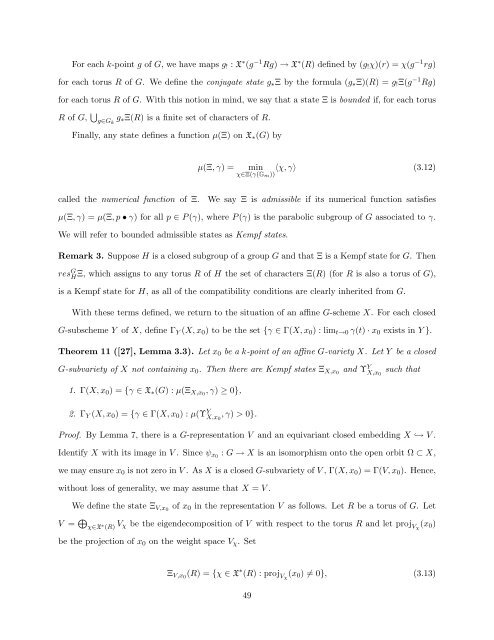Equivariant Embeddings of Algebraic Groups
Equivariant Embeddings of Algebraic Groups
Equivariant Embeddings of Algebraic Groups
Create successful ePaper yourself
Turn your PDF publications into a flip-book with our unique Google optimized e-Paper software.
For each k-point g <strong>of</strong> G, we have maps g ! : X ∗ (g −1 Rg) → X ∗ (R) defined by (g ! χ)(r) = χ(g −1 rg)<br />
for each torus R <strong>of</strong> G. We define the conjugate state g ∗ Ξ by the formula (g ∗ Ξ)(R) = g ! Ξ(g −1 Rg)<br />
for each torus R <strong>of</strong> G. With this notion in mind, we say that a state Ξ is bounded if, for each torus<br />
R <strong>of</strong> G, ⋃ g∈G k<br />
g ∗ Ξ(R) is a finite set <strong>of</strong> characters <strong>of</strong> R.<br />
Finally, any state defines a function µ(Ξ) on X ∗ (G) by<br />
µ(Ξ, γ) =<br />
min 〈χ, γ〉 (3.12)<br />
χ∈Ξ(γ(G m))<br />
called the numerical function <strong>of</strong> Ξ.<br />
We say Ξ is admissible if its numerical function satisfies<br />
µ(Ξ, γ) = µ(Ξ, p • γ) for all p ∈ P (γ), where P (γ) is the parabolic subgroup <strong>of</strong> G associated to γ.<br />
We will refer to bounded admissible states as Kempf states.<br />
Remark 3. Suppose H is a closed subgroup <strong>of</strong> a group G and that Ξ is a Kempf state for G. Then<br />
res G HΞ, which assigns to any torus R <strong>of</strong> H the set <strong>of</strong> characters Ξ(R) (for R is also a torus <strong>of</strong> G),<br />
is a Kempf state for H, as all <strong>of</strong> the compatibility conditions are clearly inherited from G.<br />
With these terms defined, we return to the situation <strong>of</strong> an affine G-scheme X. For each closed<br />
G-subscheme Y <strong>of</strong> X, define Γ Y (X, x 0 ) to be the set {γ ∈ Γ(X, x 0 ) : lim t→0 γ(t) · x 0 exists in Y }.<br />
Theorem 11 ([27], Lemma 3.3). Let x 0 be a k-point <strong>of</strong> an affine G-variety X. Let Y be a closed<br />
G-subvariety <strong>of</strong> X not containing x 0 . Then there are Kempf states Ξ X,x0 and Υ Y X,x 0<br />
such that<br />
1. Γ(X, x 0 ) = {γ ∈ X ∗ (G) : µ(Ξ X,x0 , γ) ≥ 0},<br />
2. Γ Y (X, x 0 ) = {γ ∈ Γ(X, x 0 ) : µ(Υ Y X,x 0<br />
, γ) > 0}.<br />
Pro<strong>of</strong>. By Lemma 7, there is a G-representation V and an equivariant closed embedding X ↩→ V .<br />
Identify X with its image in V . Since ψ x0 : G → X is an isomorphism onto the open orbit Ω ⊂ X,<br />
we may ensure x 0 is not zero in V . As X is a closed G-subvariety <strong>of</strong> V , Γ(X, x 0 ) = Γ(V, x 0 ). Hence,<br />
without loss <strong>of</strong> generality, we may assume that X = V .<br />
We define the state Ξ V,x0<br />
<strong>of</strong> x 0 in the representation V as follows. Let R be a torus <strong>of</strong> G. Let<br />
V = ⊕ χ∈X ∗ (R) V χ be the eigendecomposition <strong>of</strong> V with respect to the torus R and let proj Vχ<br />
(x 0 )<br />
be the projection <strong>of</strong> x 0 on the weight space V χ . Set<br />
Ξ V,x0 (R) = {χ ∈ X ∗ (R) : proj Vχ<br />
(x 0 ) ≠ 0}, (3.13)<br />
49
















